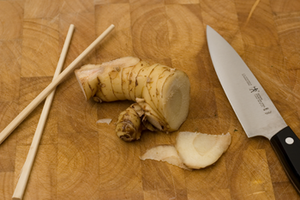Galangal
This article needs additional citations for verification. (February 2010) |



Galangal /ɡəˈlæŋɡəl/[note 1] is a rhizome of plants in the ginger family Zingiberaceae, with culinary and medicinal uses originating in Indonesia. The rhizomes are used in various Asian cuisines (for example in Thai and Lao tom yum and tom kha gai soups, Vietnamese Huế cuisine (tré) and throughout Indonesian cuisine, for example, in soto). Galangal is related to and resembles ginger. While ginger tastes a little like galangal, most cooks who use both rhizomes would never substitute one for the other and expect the same flavor.
In its raw form, galangals have a dissimilar taste from common ginger. They are available as a whole rhizome, cut or powdered. The whole fresh rhizome is very hard, and slicing it requires a sharp knife. A mixture of galangal and lime juice is used as a tonic in parts of Southeast Asia. In the Indonesian language, the greater galangal and lesser galangal are both called lengkuas or laos, while Kaempferia galanga is known as kencur. It is also known as galanggal, and somewhat confusingly galingale, which is also the name for several plants of the unrelated Cyperus genus of sedges (also with aromatic rhizomes). In Thai language, greater galangal is called "ข่า" (kha) or "ข่าใหญ่" (kha yai), while lesser galangal is called "ข่าตาแดง" (kha ta daeng). In Vietnamese, greater galangal is called riềng nếp and lesser galangal is called riềng thuốc.
The word galangal, or its variant galanga, can refer in common usage to four plant species all in the Zingiberaceae (ginger family):
- Alpinia galanga or greater galangal
- Alpinia officinarum or lesser galangal
- Kaempferia galanga, also called kencur, aromatic ginger or sand ginger
- Boesenbergia rotunda, also called Chinese ginger or fingerroot
Polish Żołądkowa Gorzka vodka is flavoured with galanga.
Footnotes
- ^ Also known as galingale /ˈɡæl[invalid input: 'ɨ']ŋɡeɪl/, galanga /ɡəˈlæŋɡə/, and blue ginger. Names in other languages include Vietnamese: "riềng" IPA: [ɾiəŋ]; Laos: ຂ່າ "kha" IPA: [kʰāa]; Thai: ข่า "kha" IPA: [kʰàa]; Burmese: "Ba dae gor"; Indonesian/Malay: lengkuas (Alpinia galanga); Khmer: រំដេង [1] "Romdeng"; Mandarin Chinese: 南薑 or 高良薑 (traditional Chinese characters), 南姜 or 高良姜 (simplified Chinese characters), nán jiāng or gāo liáng jiāng (Pinyin) IPA: [nan˧˥ tɕjaŋ˥] or IPA: [kaʊ˥ ljaŋ˧˥ tɕjaŋ˥]; Cantonese Chinese: 藍薑 laam4 goeng1 (Jyutping) IPA: [lɑm˩ kœŋ˥].
References
Further reading
- Qureshi, S.; Shah, A.; Ageel, A. (2007). "Toxicity Studies on Alpinia galanga and Curcuma longa". Planta Medica. 58 (2): 124–7. doi:10.1055/s-2006-961412. PMID 1529022.
- Bendjeddou, D; Lalaoui, K; Satta, D (2003). "Immunostimulating activity of the hot water-soluble polysaccharide extracts of Anacyclus pyrethrum, Alpinia galanga and Citrullus colocynthis". Journal of Ethnopharmacology. 88 (2–3): 155–60. doi:10.1016/S0378-8741(03)00226-5. PMID 12963136.
- Morita, Hiroshi; Itokawa, Hideji (2007). "Cytotoxic and Antifungal Diterpenes from the Seeds of Alpinia galanga". Planta Medica. 54 (2): 117–20. doi:10.1055/s-2006-962365. PMID 3406169.
- Oonmetta-Aree, Jirawan; Suzuki, Tomoko; Gasaluck, Piyawan; Eumkeb, Griangsak (2006). "Antimicrobial properties and action of galangal (Alpinia galanga Linn.) on Staphylococcus aureus". LWT - Food Science and Technology. 39 (10): 1214–20. doi:10.1016/j.lwt.2005.06.015.
- Itokawa, Hideji; Morita, Hiroshi; Sumitomo, Takayoshi; Totsuka, Nobuo; Takeya, Koichi (2007). "Antitumour Principles from Alpinia galanga". Planta Medica. 53 (1): 32–3. doi:10.1055/s-2006-962611. PMID 3575509.
- Matsuda, Hisashi; Pongpiriyadacha, Yutana; Morikawa, Toshio; Ochi, Momotaro; Yoshikawa, Masayuki (2003). "Gastroprotective effects of phenylpropanoids from the rhizomes of Alpinia galanga in rats: Structural requirements and mode of action". European Journal of Pharmacology. 471 (1): 59–67. doi:10.1016/S0014-2999(03)01785-0. PMID 12809953.
- Mitsui, Seiji; Kobayashi, Shinsaku; Nagahori, Hitoshi; Ogiso, Akira (1976). "Constituents from seeds of Alpinia galanga Wild. And their anti-ulcer activities". Chemical & Pharmaceutical Bulletin. 24 (10): 2377. doi:10.1248/cpb.24.2377.
- Matsuda, Hisashi; Morikawa, Toshio; Managi, Hiromi; Yoshikawa, Masayuki (2003). "Antiallergic principles from Alpinia galanga: Structural requirements of phenylpropanoids for inhibition of degranulation and release of TNF-α and IL-4 in RBL-2H3 cells". Bioorganic & Medicinal Chemistry Letters. 13 (19): 3197–202. doi:10.1016/S0960-894X(03)00710-8. PMID 12951092.
- De Pooter, Herman L.; Omar, Muhammad Nor; Coolsaet, Brigitte A.; Schamp, Niceas M. (1985). "The essential oil of greater galanga (Alpinia galanga) from Malaysia". Phytochemistry. 24: 93–6. doi:10.1016/S0031-9422(00)80814-6.
- Barik, B.R.; Kundu, A.B.; Dey, A.K. (1987). "Two phenolic constituents from Alpinia galanga rhizomes". Phytochemistry. 26 (7): 2126–7. doi:10.1016/S0031-9422(00)81779-3.
- Borthakur, M.; Hazarika, J.; Singh, R.S. (1998). "A protocol for micropropagation of Alpinia galanga". Plant Cell, Tissue and Organ Culture. 55 (3): 231–3. doi:10.1023/A:1006265424378.
- Haraguchi, Hiroyuki; Kuwata, Yoshiharu; Inada, Kozo; Shingu, Kazushi; Miyahara, Kazumoto; Nagao, Miyoko; Yagi, Akira (2007). "Antifungal Activity from Alpinia galanga and the Competition for Incorporation of Unsaturated Fatty Acids in Cell Growth". Planta Medica. 62 (4): 308–13. doi:10.1055/s-2006-957890. PMID 8792660.
